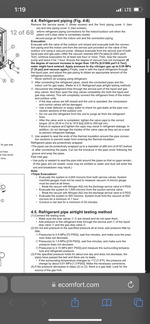FWIW I had my Mitsubishi mini-split installed a few years ago by a couple of very good professional AC installers that worked for a Mitsubishi approved dealer. I watched and talked to them throughout he entire process and they were VERY emphatic that the mini-splits needed to be very well purged and have a very good vacuum in them. A lot more so than a normal AC system due to the smaller pumps and smaller lines and orifices.
They vacuumed my system, then purged it with dry nitrogen, then pressurized it with nitrogen and closed it off and watched it for almost an hour to be sure that it didn't leak under pressure. They then vacuumed it again, and added some Freon, they then purged it again and then pulled a very low vacuum on it and ran the vacuum pump for about 4 hours until they got a very low pressure. Then they monitored it for an hour to be sure that it held that vacuum before they finally topped it all with the required amount of Freon. I've never seen anyone work on an AC system that purged and checked as much as they did or that checked the system both under vacuum and under pressure. Even after the equipment was installed and fully connected, it literally took them about 7 hours just to vacumm, purge, vacuum, test, test and retest and then fill with freon. I don't remember how low of a vacuum that they pulled but it was VERY low. Low enough that you couldn't read it with a normal AC vacuum gauge. They showed me their gauge and it was some kind of very expensive electronic gauge that would read much lower than the usual AC gauges.
Before I bought my mini-split, I got a copy of the Mitsubishi installation manuals and read them and they were very insistent about the LOW pressures that needed to be used in the system and the need to repeatedly purge the system with inert gas. After reading the manuals I decided that the necessary equipment was too expensive to buy just for my personal use so I paid to have the system professionally installed. As they were installing the system I told that to the installers and they laughed and told me that about 80% of their work was going back after people had installed their own systems and then installing them correctly and with the proper purging, testing, etc and at the required low and high pressures. They also told me that they charge as much, and sometime more, to fix people's mistakes than they did to do a proper installation in the first place.
The Mitsubishi installation manuals are online, go download them and read them.
The bottom line to me was that the VERY good vacuum pump and the Very GOOD gauges that were required would cost more than the cost (~$1000) of the installation. I already had Helium, Argon and dry Nitrogen gas and the proper regulators and such so I didn't even include the cost of any of that.
YMMV.

